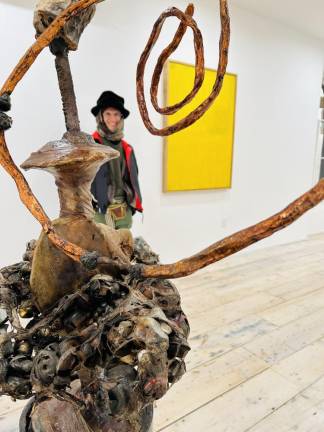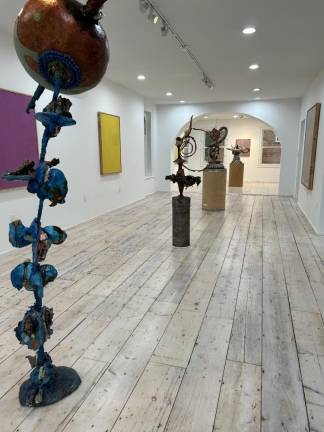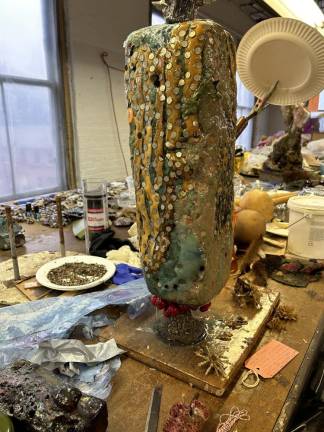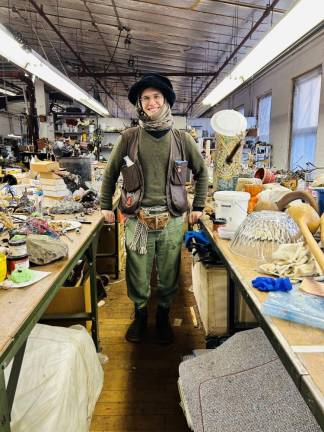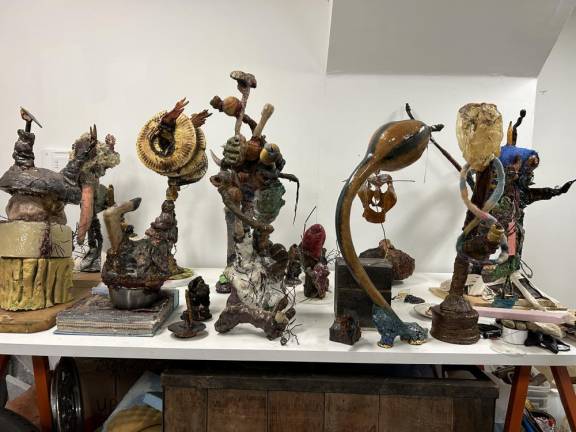The first time I encountered Daniel Giordano’s art, I was immediately captivated by the wild alchemy of his artistic practice and the playful, provocative combinations of atypical objects that comprise his sculptures and installations. A native of Newburgh, Giordano’s radical reuse breathes new life into a range of discarded materials. His recent solo show at the Massachusetts Museum of Contemporary Art included pieces that reflect the brassy, post-industrial realities of his hometown, while his current solo show at the Hyde Collection features new works that integrate found objects into outrageous sculptural combinations.
Describe some of the discarded objects that make their way into your artworks. I often collect organic matter such as dried out roadkill, garbage bags full of deceased horseshoe crabs (due to the pharmaceutical industry extracting 50% of their blood for vaccines and then releasing them back out into the wild), native and invasive plants and insects, such as cattails, water caltrops, deceased cicadas, dragonflies, northern giant hornets and spotted lanternflies. I collect a lot of clinker bricks and expired tennis balls, old tennis rackets, and discarded piles of Northeastern Fast-Dry clay tennis court surface (a connection to my background in competitive tennis), and junked sports vehicles that I find in the Highland Valley landscape.
My work encompasses the essence of the complex place I call home: the good, the bad and the ugly, Newburgh, the Hudson Highlands, the state of New York, the United States, and Earth.
How do you feel about art’s ability to change our collective consciousness with regard to Mother Earth? I don’t think of my art as activism, per se. I make art because, first and foremost, I have big fun doing it. I believe that translates. There are no rules or regulations. It brings me joy and fills my soul to the brim. It is my open forum of free expression. A spread of factors governs my decisions including the zeitgeist, economics, my locale, loved ones and more. I subscribe to George Carlin’s perspective of sitting back as a spectator and watching this social experiment unfold. It’s an anthropological study to me. This is a warped reality, the best we could come up with, apparently, yet in the high dysfunction, it yields so much poetry! I want my work to embody that duality, my perspective, and show a glimpse of the true underbelly of America the beautiful. It’s all I can do to avoid hopelessness in this apocalypse.
Tell us something we don’t know about you. I am whole food, plant-based. I exclusively cook and drink with Berkey filtered water to prevent exposure to the ubiquitous PFAS and other contaminants in our water. I don’t eat added salt, sugar, oil or animal products. I try to source locally grown food from sustainable farms whenever I can. I am fueled by beans! At one point, I considered buying a horse and trading in my car. I walk and bike places as often as possible, including walking to my studio every day. What’s good for me economically is good for me health-wise and environmentally so I came around to being a kind of environmentalist from a back door. I do my own little personal quiet acts of activism out of health and vanity. What mainly governs me is what is best for my health. Environmental collapse is always in the back of my mind. It’s all too far gone to reverse, and the Earth will simply shake us off when she’s had enough of us.
What’s good for me economically is good for me health-wise and environmentally so I came around to being a kind of environmentalist from a back door.
